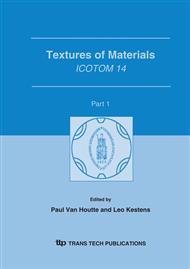p.857
p.865
p.871
p.877
p.883
p.889
p.895
p.901
p.907
The Role of Microstructural Aspects on the Performance of Coarse-Grained Superplastic Al Alloys
Abstract:
Deformed under optimum conditions of temperature and strain rate, coarse-grained aluminum alloys show elongation to failure in excess of 300%. The strain rate sensitivity index and the activation energy point to solute drag creep as the principal mechanism, a mechanism that has virtually no grain size dependence. The present study summarizes microstructural effects that are grain size dependent and which can influence the values of the maximum tensile elongation that can be obtained in coarse-grained aluminum alloys. Such effects like inhomogeneous refinement of the microstructure accompanied by the increase of the ratio of low/high angle grain boundaries and that of the texture contributes to flow stress instabilities leading to necking and premature failure.
Info:
Periodical:
Pages:
883-888
Citation:
Online since:
September 2005
Authors:
Price:
Сopyright:
© 2005 Trans Tech Publications Ltd. All Rights Reserved
Share:
Citation:


